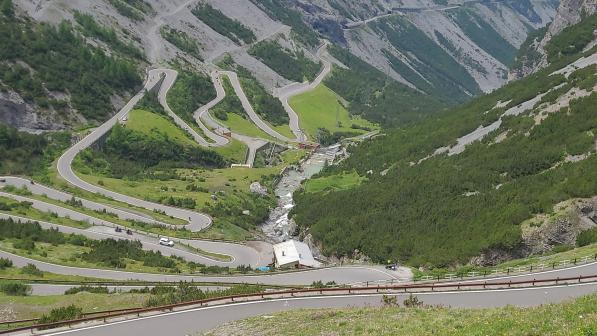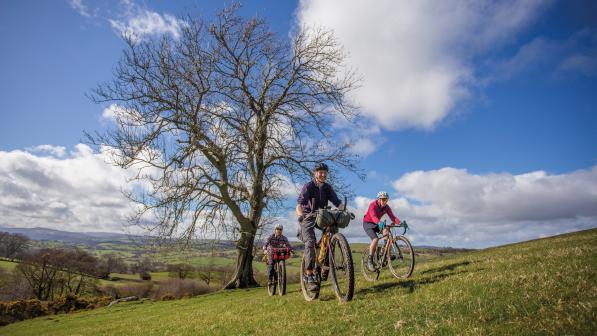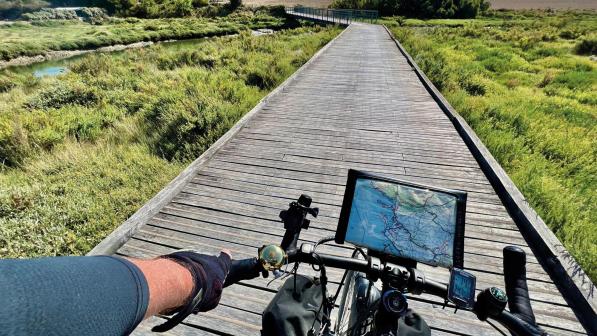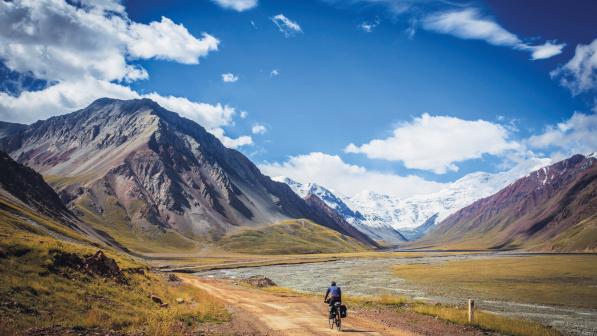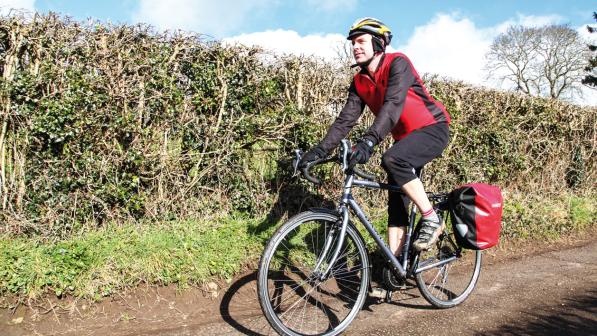Great rides: Le Grand Tour

The story began in the innocent pre-Covid days of 2019. My third book, Spain to Norway on a Bike Called Reggie, had been published a couple of years previously and, with book number four in mind, I was keen to set off pedalling once again.
By early 2020 I was planning a six-week trip from the northernmost point of Japan at Cape Soya to the country’s southernmost tip at Cape Sata. I’d bought the plane tickets and a new touring bike. My research was in full swing…
We know what happened next. Even by early 2022, Japan still hadn’t opened its doors to foreign visitors. Continental Europe had, so I came up with a Plan B, to cycle around the Baltic Sea, following the route of the EuroVelo 10. It lacked one key ingredient: my enthusiasm.
The war in Ukraine also threw up logistical problems involving Russia and its exclave of Kaliningrad. However, with a ticket already purchased for the Hull to Rotterdam ferry for the evening of 2 July, were there other options? The most obvious was to turn right on arrival at Rotterdam, not left. Plan C was born.
A cycle route odyssey
Although I have a reputation as being (as I was once introduced at the Cycle Touring Festival) ‘Mr Cycling Europe’, there are many iconic routes in Europe that I have never cycled in their entirety: the Avenue Verte to Paris, the Vélodyssée along the west coast of France, and the Rhine Cycle Route to name just three.
Could my Plan C be an opportunity to plug some of these gaps in my cycling knowledge? I pored over the map and attempted to piece together a route.
By turning right at the Hook of Holland I could follow the North Sea Cycle Route (EuroVelo 12) to Calais and the Vélomaritime (EuroVelo 4) to Dieppe. Here I could head south in the direction of Paris along the French section of the Avenue Verte, the route linking the British and French capitals.
A route I’d never before heard of, the Véloscénie, connected Paris with Mont Saint-Michel, where I could rejoin the Vélomaritime as far as Morlaix in Brittany.
From there I could follow the northern portion of the Vélodyssée (EuroVelo 1) to Royan where the Véloroute Des 2 Mers A Vélo would take me to the Mediterranean via Bordeaux, the Canal de la Garonne, Toulouse and the Canal du Midi.
The EuroVelo 17, called the ViaRhôna in France, could be followed from Sète to Andermatt, high in the Swiss Alps where, rather conveniently, the Rhine Cycle Route (EuroVelo 15) would return me to the Netherlands, the Hook of Holland and my ferry back home on 3 September. That didn’t seem too shabby for a Plan C.
Was it, however, feasible? I had negotiated a few weeks of extra holiday from the school where I teach in order to set off at the start of July, but I needed to be back in the classroom on 5 September. There was no renegotiating that.
Nine weeks. Assuming a day off every week, 54 days of cycling along a route that I estimated to be around 5,500km – just over 100km per day. I’d managed this in 2013 as I cycled along the Mediterranean from Greece to Portugal but it had left me bereft of energy as I trudged through the heat of Andalusia in the final week of the tour.
Ten years later? I was sceptical, and as the date of departure approached I was increasingly concerned that I had committed to what seemed like a doomed cycling plan. Might a Plan D be needed?
No. Just a slightly modified Plan C.

Traffic-free touring
Combining carbon-friendly modes of transport to travel longer distances needs to be championed, not shunned. With this in mind, I decided that in order to make my epic journey a more realistic endeavour, I would allow myself to take a maximum of 10 trains, each of no more than 100km.
It was a wise move and my journey was no less epic as a result. My average daily ride would now be a much more cyclist-friendly 80km per day.
To cut a longish story short – you’ll be able to read all the details in the book that I’m currently writing – I arrived back at the Hook of Holland on the afternoon of 3 September, just in time for that ferry home.
The trip had gone to plan but, as with every cycling adventure there were highs and lows, surprises along the way and challenges that had to be overcome. That’s what makes our chosen method of travel so enjoyable.
As I was following named routes, perhaps 80% of the journey was traffic free. That figure was probably closer to 100% in the first week or so of the trip as I cycled along the coasts of the Netherlands and Belgium.
It was a gentle introduction to Le Grand Tour, a ride where the vertical challenges wouldn’t really kick in until I entered Switzerland and headed in the direction of the Alps.
Even when I arrived in France, most of the cycling was well away from major roads, with cycle paths adopting the narrow lanes of the French countryside if there wasn’t a disused railway or canal towpath at hand. The French cycling authorities have done a commendable job in recent years in developing their medium- and long-distance cycling routes.
Along with their distinctive – enticing even – names (La Scandibérique, La Vélo Francette, La Route des Grandes Alpes…), each has unique branding, is well signposted and has a wealth of information available online via dedicated websites. The national website, France Vélo Tourisme, is the best place to start your planning.
Aside from the quality of the route itself (no potholes here), there were regular opportunities to pause and eat in the cafes that had moved into the disused railway stations, often having basic bicycle maintenance facilities
La belle France
Cycling south from Dieppe along the Avenue Verte, I thought I had discovered a disused railway line that couldn’t be surpassed in terms of what it provided for the travelling cyclist.
Aside from the quality of the route itself (no potholes here), there were regular opportunities to pause and eat in the cafés that had moved into the disused railway stations, often having basic bicycle maintenance facilities available. Yet the experience would be repeated over and over again as I continued on my long loop around France.
There were several such abandoned railways linking Paris with Mont Saint-Michel, more along the Vélodyssée and, when leaving Bordeaux, I followed the superb Voie Verte Roger Lapébie linking the great city of wine to the Canal de la Garonne some 40km to the south-east.
Many of these disused railway lines have been officially adopted as departmental roads (without cars). This requires the local authorities responsible for them to maintain them to a high standard. If only that were the case nearer to home…
Combined with the canal towpaths, much of my cycle journey came courtesy of the toil of hardworking navvies of the 17th, 18th and 19th centuries.
Crossing Paris early on in the trip, I did make life difficult for myself by not sticking to the route of the Avenue Verte as I made my way through the city’s suburbs.
It wasn’t easy when the signs had to fight for my attention among all the other urban clutter but I knew my destination was somewhere south and, making use of the compass on my handlebars, eventually arrived at Notre Dame in time to make it to my Warmshowers host’s flat in the nearby Marais district.
He proved to be an excellent host, giving me a guided tour of the 4th arrondissement and fascinating insights into the changing face of his corner of Paris.
I had equally memorable Warmshowers experiences on a co-housing project near Ostend, and with a wonderfully welcoming non-cyclist in Agen (she had stumbled on a lost cyclist in the street a couple of years previously and had been taking them in ever since).
I even attended a birthday party with the extended family of a sprightly 78-year-old in Sierre, Switzerland.
Most nights were, however, spent in the tent and I’m delighted to report that, despite reports to the contrary, the French municipal campsite is alive and kicking.
Famed for their locations near town centres, their facilities and above all their prices, the standout example was the Camping Municipal Champ Passais in the Normandy town of Domfront, which still charges just €4 per night for a cyclist and their tent.
The facilities were about as good as you can get, and the beautiful hilltop town was only a few minutes up the hill.

Midi problems, maxi climbs
One disappointing section of Le Grand Tour was the Canal du Midi. I’d interviewed Declan Lyons, author of the Canal du Midi Cicerone guide for the Cycling Europe Podcast earlier in 2022, and I was aware that some sections of the towpath were hard going.
In cycling from Toulouse to Sète, I came to the reluctant conclusion that if you really want to travel along the canal, the best thing to do is hire a boat.
It’s a great shame as, in all other respects – the canal itself, its history, the surrounding countryside and nearby towns such as Carcassonne – it’s a wonderful area through which to travel, just not on a bike on the towpath.
It also suffers from being the second half of the Canal des 2 Mers A Vélo, the first part of which is along the superb Canal de la Garonne. The comparison between the two canals is stark.
I had few expectations for the ViaRhôna. At the planning stage it was the part of the journey that simply linked two other places where I wanted to be: the Mediterranean and the Alps. It turned out to be the highlight of the entire trip.
Again, money has been invested into the route and it’s very visible in the quality of the traffic-free sections, often along the river. I lost count of the number of bridges that I crossed but at 8am one morning, under a blue sky and with not another soul in sight, crossing the rebuilt suspension bridge near Rochemaure was a magical experience.
Destroyed several times over its lifetime, it has now found a fitting purpose in transporting pedestrians and cyclists across the River Rhône.
After Lyon, the ViaRhôna took my route in the direction of Switzerland. Mountains became a feature of the trip for the first time.
That said, it wasn’t until after several days cycling in Switzerland that the major physical challenge of the cycle presented itself: the climb to the Furka Pass at 2,436 metres.
Following in the tyre tracks of Sean Connery in his Aston Martin in Goldfinger, it was a long climb but one that was rewarded with Alpine views and a long descent into the valley to Andermatt and the same campsite where I’d stayed overnight in 2010 en route to the Gotthard Pass and Italy.
If you happen to have read that first book, you’ll be delighted to hear that I had no repeat problems with spokes in 2022. My new bicycle (a bike called Wanda…) is made of strong stuff.
A Koga WorldTraveller, complete with carbon belt and Rohloff hub, she performed superbly throughout the trip. Not even a puncture, courtesy of the Schwalbe Marathon Plus tyres.
Downhill and home
My onward journey along the Rhine required another climb to the Oberalp Pass, but having just earned my spurs at the Furka Pass, I chose to take one of my trains. It was train number eight of the trip.
The previous ones had been chosen for a variety of reasons – to make progress (Calais to Le Touquet), avoid suburbs (Paris to Chartres), to relieve the boredom of cycling along the Nantes-Brest Canal (Redon to Couëron)…
But, here in Switzerland, it was because I fancied taking one of the little red trains that had been passing me along the Swiss valleys for days. Nothing whatsoever to do with it being another strenuous climb.
From the Oberalp Pass it was, literally, downhill all the way as I headed east through Switzerland before swinging west and then north along the Rhine. Time began to play on my mind. I left Andermatt on 23 August so I had just 12 days to get back to Rotterdam, the Hook of Holland and my ferry home.
The two remaining trains helped, as did a ferry on the Bodensee from Bregenz to Konstanz (after drinking far too much beer with a German friend I’d met up with for lunch). Even so, I wasn’t confident of completing the loop on time until the very end of August, and it did require some long days in the saddle.
Yet where better a place to spend hours in the saddle than back in the cycling nirvana of the Netherlands? I reached the sign at the Hook of Holland in the mid-afternoon of 3 September. My ferry back home to Yorkshire departed at 8pm that evening. I was back in the classroom just 36 hours later…

